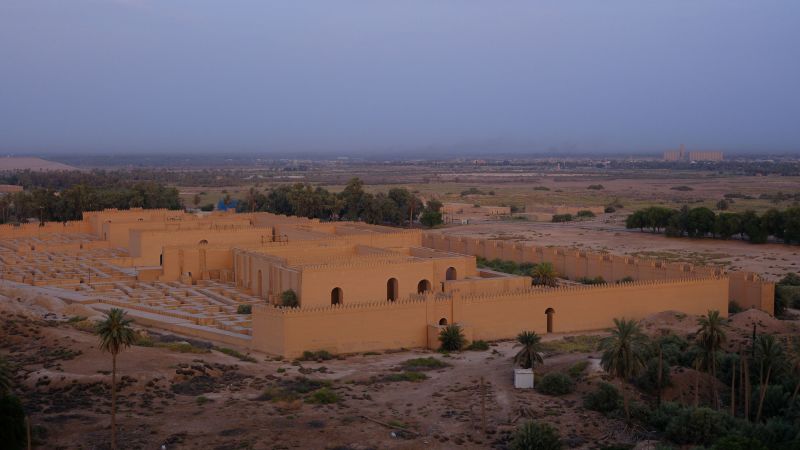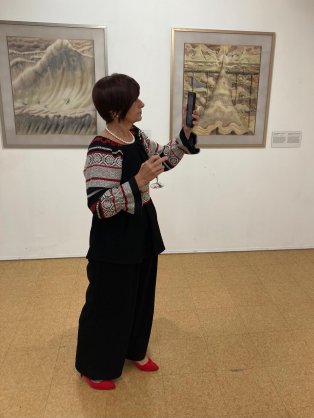
The sun hangs heavy over central Iraq in late afternoon, painting the ruins of Babylon in heat and light. Dust rises from the ground in soft clouds, carrying a faint scent that seems older than time itself. In this moment the city feels both empty and eternal, its silence broken only by the shuffle of a few travelers who have come to stand in the footprints of kings.
Once, Babylon was the jewel of Mesopotamia, the city that gave its name to entire eras— the Old, Middle, and New Babylonian periods. It was here that Nebuchadnezzar II ruled, where colossal temples and palaces were built, and where poets and chroniclers imagined one of the Seven Wonders of the Ancient World: the Hanging Gardens. Today, inscribed as a UNESCO World Heritage Site yet still at risk, Babylon rests in a delicate balance between grandeur and decay.
To walk through Babylon is to walk through layers of myth and memory. The first sight greeting many visitors is the reconstructed Ishtar Gate, its deep blue surface once adorned with lions and dragons in golden relief. Beyond it stretches the Processional Way, a ceremonial road once used for royal festivals like the Akitu New Year — said to be one of the world’s oldest celebrations.
Here, Nebuchadnezzar II, who reigned from 605 to 562 BCE, stamped his mark on history. He built palaces and temples of staggering scale, expanded the city’s defenses, and left inscriptions that still proclaim his power. The massive Etemenanki ziggurat — believed by some to have inspired the biblical Tower of Babel — once dominated the skyline.
And then there are the Hanging Gardens. Ancient Greek and Roman writers described them as a lush paradise of terraced greenery, watered by ingenious pumps that lifted water from the Euphrates. According to legend, Nebuchadnezzar commissioned them for his queen, Amytis, who longed for the forested mountains of her homeland.
‘I’ve waited my whole life’
For Iraqi archaeologist Amer Abdulrazzaq, the gardens are more than myth. “I confirm that the Hanging Gardens of Babylon existed,” he tells CNN. They are, he adds “a reality that reflects the beauty, grandeur and creativity of the Mesopotamian engineer and artist, the Babylonian engineer, and the greatness of the king and rule in Babylon.”
Abdulrazzaq believes the gardens were located at what is today a sprawling archaeological site on the shores of the Euphrates river, near the city of Hillah, about a two-hour drive due south of Baghdad.
Others point to Nineveh, hundreds of miles to the north, as a possible location, but for travelers arriving in Babylon the debate hardly matters. Standing amid the ruins, it is easy to imagine terraces dripping with vines, waterfalls tumbling down stone columns, and the hum of life in a city at the height of its glory.
Despite years of conflict and uncertainty in Iraq, Babylon continues to attract travelers from abroad in numbers that are steadily increasing but still a far cry from the crowds who would come decades ago. In 2024, the site saw 49,629 visitors, of whom 5,370 were foreigners, according to the Antiquities and Heritage Directorate in Babylon.
On a recent summer afternoon, three visitors could be found wandering its paths. Among them was Gianmaria Vergani, a 35-year-old from Milan, whose fascination with the Hanging Gardens stretched back to childhood. “I have waited my whole life to stand here,” he told CNN.
Vergani had spent months preparing, poring over maps and histories before flying to Baghdad. His journey included a stop at Taq Kasra — the two-millennia-old great arch of Ctesiphon — southwest of the Iraqi capital before he turned south to Babylon, intent on seeing the ruins for himself.
“When I saw the Ishtar Gate at the start of the tour, I was overwhelmed,” he said, his voice trembling. “It’s unbelievable to think that thousands of years ago, people walked these same paths. As I reached the site, I felt like my dream had finally come true.”
His reverence is echoed by many who make the journey. Babylon is not a place for casual tourism; it is a destination of pilgrimage, a chance to step into the stories that shaped civilizations.
Love vs. money
Yet Babylon is also a site in distress. The approach to the ancient city hints at the contrast: the main road circling the ruins is in acceptable condition, but the streets leading there are broken and rutted. Inside the site, pathways are overgrown with weeds, unkempt plants push through cracks, and litter is strewn among the stones. Cigarette butts and plastic bottles lie scattered in courtyards where kings once received foreign envoys.
Facilities are scarce. Restrooms exist, but only after the ticket booth near the Ishtar Gate. There is no hotel nearby, forcing travelers to return to distant accommodations after their visit. Signage is minimal; without a guide, visitors can easily lose their way among the walls and chambers.
Local guides do their best to shield guests from disappointment, steering them down cleaner routes and framing the ruins in their best light. But for independent travelers the neglect is obvious. The city appears to require urgent cleaning and care.
Raed Hamed Abdullah, head of the Ministry of Culture’s Antiquities and Heritage Directorate in Babylon, acknowledges the challenge. “The entire archaeological site has just four cleaning workers,” he explained. “Sometimes I even ask the guards to help with cleaning. These are individual efforts we make out of our love for the city. We hope the Iraqi government will allocate sufficient funds to care for Babylon.”
So far, meaningful support for the site’s day-to-day upkeep has been limited. Regional authorities provide piecemeal maintenance, but broader development — from visitor facilities to proper conservation — remains tangled in legal and political obstacles.
Babylon’s scars are not only caused by age. Its ruins have been repeatedly reshaped by modern rulers and armies.
In the 1980s, Saddam Hussein embarked on an ambitious reconstruction of Babylon, apparently seeing himself as the heir of Nebuchadnezzar. Entire walls were rebuilt with new bricks stamped with his name. A massive palace rose nearby, its terraces overlooking the ruins in a display of power rather than preservation.
Arabic calligraphy etched into the walls appears sacred at first glance, but closer inspection reveals not verses of scripture, but the stylized initials of Saddam himself. The project was propaganda, embedding his presence in the city’s ancient narrative.
After the US-led invasion in 2003, American forces established a base in Babylon, converting Saddam’s palace into their headquarters. Helicopters landed directly on the archaeological site. Tanks crushed fragile ground. Soldiers scrawled graffiti across the palace interiors. Babylon, once a symbol of power and glory, became collateral damage in modern struggles for dominance.
Graffiti and theft
For visitors today, the impact is striking. “It was heartbreaking to see the palace in neglect, covered in graffiti,” said Vergani. “The lack of security was absurd; artifacts could easily be stolen.”
When UNESCO added Babylon to its World Heritage List in July 2019, it was hailed as a triumph for Iraq, the culmination of decades of lobbying. But recognition alone has not guaranteed preservation. Funding remains limited, plans for development are stalled, and the site relies heavily on the devotion of its local guardians.
“Babylon is one of the most important tourist sites in Iraq and the world,” Abdulrazzaq emphasized. “It needs a special financial fund from the prime minister’s office to become a focal point for all tourists.”
Until that happens, Babylon’s survival depends on fragile efforts: four cleaners with brooms, guides weaving stories, archaeologists pleading for resources. The city of kings and myths waits once again for the attention it deserves.
In recent times, international nonprofit World Monuments Fund has been carrying out conservation work on parts of Babylon, including a project to study and restore the site’s Ninmakh Temple, dedicated to a female deity, with the support of the US Embassy.
But with the many challenges the site faces, it is often individuals rather than institutions who keep Babylon’s story alive. Among them is 22-year-old tour guide Hussein Hashem, born and raised in Babylon.
His passion for history began in middle school, fostered during class trips to the site. Later, after graduating from the University of Babylon with a degree in biomedical engineering, he turned to tourism, where his knowledge and language skills opened a new path.
“Through my work, I try to send a positive message,” Hashem explained. “Iraq is safe and beautiful, not as it’s portrayed on TV and social media. I wish everyone could visit my country to see its history, people and culture for themselves.”
‘Simply amazing’
Visitors frequently ask him about the Hanging Gardens. Hashem recounts how German archaeologists once believed they had found them in a complex of chambers on the site. Iraqi teams later established that the space was used for food storage. Some scholars point instead to a site near the Euphrates, between the ruins of Babylon and Saddam’s palace.
Despite his pride, Hashem worries about the lack of investment. The site needs more government support and public awareness, he said. He also urges visitors to respect the ruins, to resist leaving litter or carving their names into ancient stone.
To wander Babylon is to experience contradictions. The Southern Palace reveals walls etched with Nebuchadnezzar’s inscriptions alongside Saddam Hussein’s. The famed Babylonian Lion still crouches in silent defiance, though weeds climb its pedestal. The original Ishtar Gate, dismantled in the early 20th century, sits thousands of miles away in Berlin’s Pergamon Museum, leaving visitors here to marvel at a partial reconstruction.
The surroundings only sharpen the contrasts. Beyond the archaeological boundaries lie orchards, picnic gardens, and residential houses. A police station stands watch nearby.
Despite everything, Babylon continues to cast its spell. Visitors still stand in awe before the Ishtar Gate. They still debate the Hanging Gardens, still marvel at the possibility that such a paradise once rose from the desert plain. Scholars continue their research, while travelers carry stories home to families and friends who are astonished to learn that they walked the streets of Nebuchadnezzar’s capital.
For Italian tourist Vergani, touring Babylon was the culmination of a fulfilling vacation in Iraq: “Beyond its beauty and history, what I appreciated most about Iraq was its people — kind, helpful, smiling, simply amazing.”



